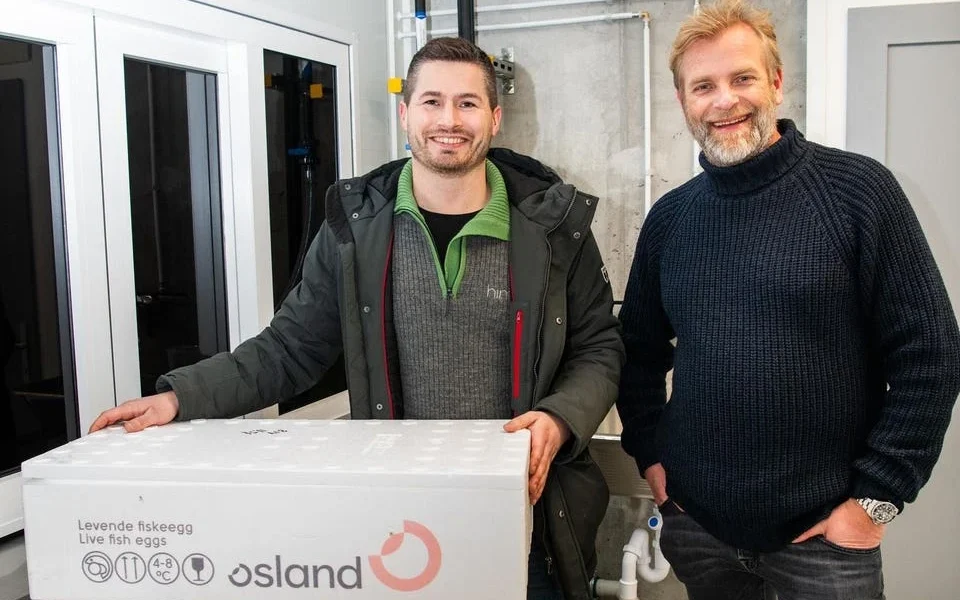A Norwegian Company Set Up A Land-Based Aquaculture Farm. But It’s Not Salmon They Bet On
A batch of 420,000 trout roe grains were delivered to Hima Seafood’s land-based fish plant, leading to the production of 8000 tonnes of premium trout per year. On January 5, the Norwegian sustainable food company Hima Seafood launched its first land-based aquaculture project, a 30,000 square meter Norwegian trout farm running on its groundwater, by welcoming the delivery of 420,000 trout grains egg.
This is the first large scale fish farm based on a modern freshwater recycling aquaculture system (RAS), able to clean the water as it enters and exits the fish farm. The project received a $ 250 million (NOK 2,5 billion) investment by sustainability firm Foresight and personal funds, the single largest private placement package within land-based aquaculture. “The investment went to develop a new sustainable way of food production, protecting the environment and animals,” said Sten Falkum, CEO of Hima Seafood.
A Sustainable Approach to Aquaculture
With the first plant, Hima Seafood is tapping into the underexploited fish species, which can produce 8000 tonnes of premium trout per year. For the past decades the high demand for salmon placed Norway at the forefront of production but lately the Norwegian salmon farming industry — which is 99,9% aquaculture-based — has been under heavy scrutiny. Earlier this autumn, the Norwegian food Safety Authority inspected several of the facilities along the Norwegian coast, finding that animal welfare standards were poorly adopted, leading to dead fish floating in the pens and the rapid spread of diseases.
Several EU countries and Israel expressed concern about the quality of the fish received with often bad smells and open wounds. Moreover, sewage from aquaculture heavily polluted the ocean waters, causing the endangerment of local biodiversity. Impact investment – which channels more capital to the solutions of tomorrow – in the Nordic is big, but when it comes to aquaculture, venture capital firms are not placing investment. As stated by Linn Hege Aune, ESG & sustainability manager from the Norwegian group Investinor, during Oslo Innovation Week 2023, the sector needs to solve its issues if it wants to receive more funds, and investors are waiting for that moment.
The Ecological Advantages of Aquaculture
Hima Seafood’s new aquaculture Business seems to avoid many faulty issues that are taking the salmon Business down, by not turning a blind eye to animal welfare and environmental protection. Its farm system is based on three main inputs: clean water, no diseases, and no stress factors. The choice of a different fish to farm is also not casual. Like their most hyped counterparts, trouts are also part of the salmonoid fish family, with similar nutritional characteristics.
The species of trout selected by Hima relies only on freshwater and therefore can be placed on land and be fed crystal clear water. It is also less territorial than salmon, which makes it easier to tame. To clear the water, the Business uses a technology delivered by the Norwegian company Eyvi: “We invested in a modern effluent treatment plant removing nitrogen and phosphor from the effluent water. Additionally, we have full sludge drying and hygienization capabilities, enabling use of the nutritious sidestreams as organic fertilizer,” he said.
Environmental Impact and Sustainability
The company seeks to clean the water as it comes in, as in both rivers and oceans, it naturally contains pathogens, which leads sea-based aquaculture companies to use vaccination: “With our system, there is nothing we need to vaccinate against,” told Falkum. The farm’s technology also handles fish transportation inside the farm, continuously moving the trouts: “This is done in kind of underwater rivers. We gently move them so they don’t feel stressed.”
As the animals swim their whole life, in a protected environment, Hima Seafood expects its fish mortality to be far lower than the industry average of 16% mortality rate. Because Hima does not use antibiotics nor salt water, it plans to collect the bacteria, and biomaterial – such as feed residues and excrement – that deposits at the bottom of the pools, to make organic fertilizers. The biomaterial is collected before the water is cleaned again to be released in the lake and can be transformed into a key ingredient for organic fertilizers.
Economic Prospects and Market Expansion
In the Rjukan fish farm, the water treatment solutions company Sterner Group AS will purify the sludge produced, and later turn it into high-quality organic fertilizers to commercialize. According to Falkum, organic fertilizers will be key actors in revert soil erosion which has been mainly caused by the overuse of chemical fertilizers: “When using or reintroducing organic fertilizer only within two years farmers can see the benefits, and biodiversity is basically back.”
It takes between 14 to 16 months for a trout to fully develop and be sold on the market. The first batch of 420,000 roe grain eggs of the oldest native trout provided by Osland Settefisk was transported on January 5 and will hatch shortly. Hima states it will initially sell its premium sashimi graded trout to restaurants, hotels and retailers in selected markets in Norway and Europe. A quota of the yearly produced trout would be marketed, to Germany, Italy, and France, as supermarket chains have shown interest in signing up to a fixed volume.
Global Expansion and Future Sustainability
“We will produce a predictable volume every day. At sea, you cannot do that when all the fish is grown at the same time,” Falkum said. But the real product might be the fish farm itself, as Falkum says that Hima Seafood farms worldwide could help countries self-support red fish production internally as well as increase organic fertilizers Manufacturing. The company is already working on building a plant in North Carolina. More plants are expected to be built in the US close to freshwater streams, where they could have a higher capacity than the fish farm in Rjukan: “Investors behind those projects are only waiting for the success of the plant in Norway,” said Falkum, which will have to demonstrate the feasibility of its project within a year’s time.
Source: forbes








No Comments